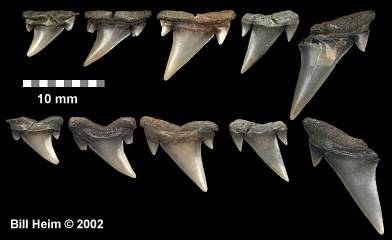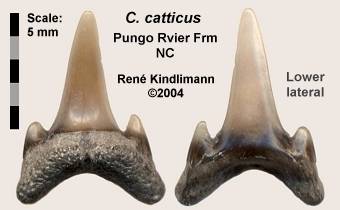|

The below specimens are very scarce Pungo River teeth that have generated much discussion over the years. Do they represent the extinct lamnid Carcharoides catticus PHILIPPI, 1846 or the extant genus Triaenodon M▄LLER & HENLE, 1837?
Purdy et al. (2001) not only ascribed the Lee Creek teeth to Triaenodon obesus, but went on to synonymize Carcharoides with Triaenodon. Later that year, Ward & Bonavia pointed out odontological characteristics that differentiated the two genera. Comparing Carcharoides to the extant genus, they point out that catticus teeth can be clearly separated into anteriors and laterals (lamniforms have two tooth hollows) while the gradient monognathic heterodonty of obesus is characteristic of the single tooth hollow of a carcharhinid. In addition, the Carcharoides' crown histology is osteodont (lamniform characteristic) while in obesus it's orthodont.
This page had originally (1997) ascribed these scarce Lee Creek teeth to Triaenodon. In light of the above, in 2002 we revisited this topic. In reviewing the available Lee Creek specimens, we concluded these teeth differed from those of C. catticus. We acknowledged the similarity of crown and cusplet design, but were concerned by the deep nutrient grooves (a carcharhinid feature) of the Lee Creek specimens. We were also hesitant in ascribing these teeth to T. obesus. Although not common, recovered specimens failed to reflect anterior and posterior tooth-designs as seen in the extant species (an Indo-pacific taxa). It was our position that they be best referred to as cf Triaenodon for the time being.
In 2003, continued attention to this topic led to the addition of a Carcharoides genus page. RenÚ Kindlimann's material included a lower tooth (fig 2), preservationally consistent with 'reject' Lee Creek upper laterals (fig. 1), and of the C. catticus design. In addition, this material also included upper laterals in excellent preservation. These teeth were undoubtedly C. catticus. It now appears difficult to accept Triaenodon as present in the fauna. The deeper than normal nutrient grooves may only be a preservational byproduct.
 |
| Fig. 1 - Carcharoides catticus — Pungo River Formation |
 |
| Fig. 2 - Carcharoides catticus — Pungo River Frm |
|